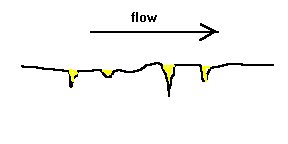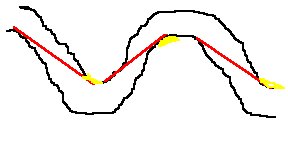Let's get Physical
copyright © 1995 | 
|
copyright © 1995 | 
|
It's funny what you can find when you're not looking for anything specific. I was just looking through the flyer that the school system puts out advertising higher education. The class title jumped off the page and hit me in the face. "Beginning gold prospecting," it said. My first thought was, "This is too good to be true. It's close to where I live, and it's affordable."
It was real all right. I leaped at the chance to learn more than I knew, which was very little. I drove to an area high school on the appointed night, laid down the $35 fee, and looked forward to soaking up knowledge.
The instructor spent a lot of time discussing the physical properties of gold, and at first I was a little disappointed. "Who cares what the atomic weight of gold is, or all the rest of this stuff. I want to know where to find it, and how to get it out of where it is." By the end of the class, I had learned that knowing about the properties of gold led toward knowing the other things also. What are these properties, and why are they important? Stick around; I'll tell you.
One of the advantages of having gold, as opposed to money, is that it doesn't suffer from inflation. In the middle 1800's, gold sold for $17 per troy ounce and bread sold for $.05 per loaf. Today gold sells for about $450 per troy ounce and bread sells for $1.30 per loaf. Both have gone up about 26 times. Another way of looking at it is to say that the dollar is only worth 1/26 as much as it was in the middle 1800's. The dollar has inflated.
Physical Properties
Gold is the most malleable and ductile of any metal. That means it's easy to work with, it can be hammered into sheets or drawn into fine wire. It is very soft, and very dense. It conducts both heat and electricity quite well. It is bright yellow, and has a high luster. Gold melts at about 1947 degrees Fahrenheit (1064 C) and boils at about 2808 degrees.
Let's consider the malleable and ductile thing. Ever seen fool's gold? It can look just like gold, and has fooled lots of people including me. So let's say you have this gorgeous chunk of stuff, and want to know if it's worth getting excited about. Try squeezing it a little with pliers. If it's ductile, it will mash down a little. Try tapping it with your geologist's hammer. If it's malleable, it will bend and flatten out. If it bends like a piece of solder, put it in your pocket and go get some more. If it shatters like glass or ordinary rock, it's probably no big deal.
Gold is very soft, with a hardness of 2.3 on the Mhos scale. Take out your pocket knife, and poke your hunk of gorgeous stuff. Does it dent easily? It will if it's gold.
Can you spot gold by it's color? It's usually bright yellow and has a high luster. But fine gold, like other metallic powders, is black; if suspended in clay or some other colloid where the particles are almost molecular size, gold ranges in color from ruby red to purple.
Now we can test our samples to see if what we have is gold.
Color test: It's usually a bright brassy yellow.
Glitter test: It does not glitter, it shines. Mica glitters.
Hardness test: It's very soft, and will dent or bend. Gold never shatters.
The acid test: Nitric acid has no effect on gold; it may clean off impurities, however.
These tests work well if the piece you have is large, but I've got some bad news for you folks. The rarest form of gold found on the planet is called a nugget. Most of the gold you will find will be dust, perhaps as fine as flour. This fact doesn't stop miner's from getting it. Many large operations are mining gold that's microscopic, and they find it only by chemical analysis. Still, it's pretty hard to hammer or squeeze flour, so we rely on another property; specific gravity.
Gold has a specific gravity of 19.3. That means it's almost twice as heavy as lead, two and a half times heavier than silver, and eight times heavier than quartz. You may think that that rock you dropped on your foot was heavy, but if it had been gold, you would have crushed a toe. You'd have had trouble picking it up in the first place.
I can pick up a granite boulder that's one cubic foot, and I have a bad back. A block of gold that were one cubic foot would weigh 1187 pounds (and be worth about 6.5 million dollars). This stuff is heavy! I can't stress that enough. The heaviness of gold is the property that makes a gold pan work. A sluice box, a trammel, a gold wheel, and almost every other contraption ever used to separate gold from garbage works because gold is so heavy.
The instructor had a large plastic box, which he had filled with puffed wheat type cereal. He put a foozball in it, and told us how the relatively heavy foozball will tend to sink to the bottom. He shook the box, and a white ball soon appeared on top. We all laughed at his apparent embarrassment, but he said, "That's a ping-pong ball I put in earlier. The foozball's on the bottom." He held the box up so we could see through the bottom, and sure enough, there it was. The heavy stuff goes to the bottom, and the light stuff goes to the top. Remember that. The reason gold prospectors look for bedrock is because the gold can't get any lower than that.
Measurement systems
Most 'native' gold is about 80% pure, with the rest being silver or copper. The 'carat' system that jewelers use rates 100% pure gold as 24 carat, 18 carat gold is 75% pure, and 12 carat gold is 50% pure. 14 carat gold is then 14 divided by 24, or 58% gold.
The size of the pieces is determined with a mesh. Mesh in turn is measured by the number of openings per linear inch. Nuggets won't pass through a 10 mesh screen. Flakes won't pass through a 20 mesh screen. Anything smaller is considered fine gold.
Gold is measured and sold by the Troy system. In this system, 24 grains equals 1 pennyweight. 20 pennyweight equals 1 Troy ounce. 12 Troy ounces equal 1 Troy pound. A troy pound is 0.3732 kilogram, while the pound that most of us use is 0.4536 kilogram.
You'll see ads for scales that will weigh small things very accurately, but they weigh in grams. 64.8 milligrams = 1 grain, 1.552 grams = 1 pennyweight, 31.104 grams = 1 Troy ounce, and 373.241 grams = 1 Troy pound. I would hope these scales come with a conversion chart, but if not, now you have one.
Where is it?
Gold is found in lode deposits, residual deposits, alluvial deposits, bench deposits, streambed deposits, ancient rivers, and flood layers. A lode deposit is a crack or fissure in hardrock that's full of gold. This is the original source of placer deposits.
Residual deposits are pieces of ore that have eroded away from a lode. They are usually directly under the lode that they broke away from.
Alluvial deposits are pieces of ore that have eroded away from a lode, but haven't been deposited in a stream. The hill that they came from may no longer exist, or may even be further downhill.
Bench deposits are found on the banks of a stream, and streambed deposits are found under the water. You can start your exploration in the streambed. If you don't see any signs there, chances are that the entire basin is bare.
Look for cracks or crevices in the rock at the bottom of the stream. Gold will settle into them. Any rough or irregular bedrock surface will act as a gold trap. Potholes in the bedrock will trap gold, so dig until you find the hard edges of the hole. Smooth and polished surfaces don't trap gold well.
Dikes in the bedrock will trap gold in different ways. If it angles downstream, gold will to collect on the downstream side. If it angles upstream, it will tend to collect on the upstream side. Rock outcroppings from the stream sides work about this same way.
Any sudden drop-off into a deeper and larger volume of water is a good place to look. Boulders at the base of a waterfall will protect gold deposits from being boiled away by the falling water. Sometimes the gold will settle out just beyond the boilout point. If the slope of the streambed lessens and smoothes out, there may be a good sized deposit there. Look on topographical maps for places where the grade levels off and check it out.
Gold tends to follow the shortest route between bends.
Boulders in the stream may trap gold on the downstream side. Of course, if they are in the shortest path, they are even more likely to do so.
During the Tertiary period, about 2 million years ago, the mountains underwent a lot of twisting and faulting. Many streams were formed, most of which ran in a South-East direction. The benches of these ancient rivers and streams are well known for the rich deposits they contain. These deposits often have a deep blue color, and are called 'Blue lead', which turns a rusty reddish brown after being dug up and exposed to the air. They are often very hard and compacted.
Flood gold can be found at the bottom of flood layers where heavy storms with enough force to move large amounts of gold will produce concentrations. Watch for layers of differing color, hardness and consistency. Some hard layers may masquerade as bedrock, so don't give up if the going gets a little hard. The shortest route idea applies here, also. Sharp bends may show good return in the inside edges quite far from the normal water line.
Maybe this is a good place to quit. Next time; another panning method, running a sluice box, where to look, where not to look, and how to file a claim.
Return to The Greenhorn's Gold Stories
 Get your own Free Home Page
Get your own Free Home PageCopyright © 1998 by Greenhorn Publications